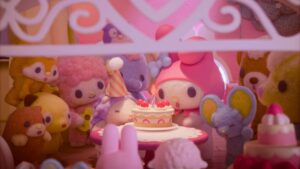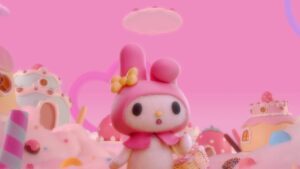


 If there’s one thing Sanrio has built a reputation for, it’s not judging a book by its cover. No, I’m not just talking about cutesy, wackadoo Sanrio girls – all of the series that they’ve produced for Netflix so far have had very cutesy covers and artwork that might have a “normal” adult – if such a concept exists – believe that there’s nothing beyond the surface for them. Yet, much like Aggretsuko and Rilakkuma and Kaoru, much exists beneath the cute characters. These mascots live surprisingly complex lives of adult realism, though in a way that distinctly sets them apart from the “adult cartoon” stereotype. Rather than having the characters gratuitously swear or hack one another apart, the story here is more likely to resonate with viewers of all ages in a far more gentle way. Even still, the cuteness and abundance of sweets can’t hurt.
If there’s one thing Sanrio has built a reputation for, it’s not judging a book by its cover. No, I’m not just talking about cutesy, wackadoo Sanrio girls – all of the series that they’ve produced for Netflix so far have had very cutesy covers and artwork that might have a “normal” adult – if such a concept exists – believe that there’s nothing beyond the surface for them. Yet, much like Aggretsuko and Rilakkuma and Kaoru, much exists beneath the cute characters. These mascots live surprisingly complex lives of adult realism, though in a way that distinctly sets them apart from the “adult cartoon” stereotype. Rather than having the characters gratuitously swear or hack one another apart, the story here is more likely to resonate with viewers of all ages in a far more gentle way. Even still, the cuteness and abundance of sweets can’t hurt.
My Melody is one of the most popular people in Mariland – not that she cares to notice. With her friends by her side, she’s figured out how to make some of the most delicious sweets anyone has ever tasted – much to the enragement of Kuromi, her frenemy next door, who intends to open her own sweets shop. The main issue? Kuromi’s ‘exotic’ desserts are far more likely to bring up the rest of your stomach contents than urge you to give compliments to the chef. As Kuromi attempts to steal the spotlight from My Melody, she discovers a dark secret that can bring her all of her desires…but nothing comes without a price.
 My Melody & Kuromi has the same art style as Sanrio’s Rilakkuma and Kaoru – the stop-motion does work just as well for their world as it does Rilakkuma’s. It honestly looks more appealing than computer animation likely would have, though if you look too closely, the white on My Melody and Kuromi makes it look a bit like they’re made out of rice…which the show itself might know, as Kuromi angrily protests being called a “riceball” at one point. At least she’s not a jelly-filled donut – in fact, donuts are one of the few sweets that are absent from the series. This might not be the best series for those attempting to watch their sugar intake, as there’s a constant plethora of delicious desserts filling the screen. Unless you skip to Kuromi’s scenes, which could help your diet. (The thought of onion cake is an assault on every single sense at once.)
My Melody & Kuromi has the same art style as Sanrio’s Rilakkuma and Kaoru – the stop-motion does work just as well for their world as it does Rilakkuma’s. It honestly looks more appealing than computer animation likely would have, though if you look too closely, the white on My Melody and Kuromi makes it look a bit like they’re made out of rice…which the show itself might know, as Kuromi angrily protests being called a “riceball” at one point. At least she’s not a jelly-filled donut – in fact, donuts are one of the few sweets that are absent from the series. This might not be the best series for those attempting to watch their sugar intake, as there’s a constant plethora of delicious desserts filling the screen. Unless you skip to Kuromi’s scenes, which could help your diet. (The thought of onion cake is an assault on every single sense at once.)
My Melody and Kuromi themselves are, as the title suggests, the main stars here, but the show’s side characters bring plenty of entertainment as well – My Melody is accompanied at the bakery by Felt, a quiet but ambitious mouse who’s at times overwhelmed by My Melody’s radical optimism, and Piano, a sheep who doesn’t speak much but can DJ like no one’s business and will defend her man’s honor with a chainsaw. (I still assure you nobody gets hacked apart.)
 While the series carries a TV-PG rating from Netflix with advisories for “fear, language, violence”, the show’s art style and My Melody’s chipper attitude keep it from ever being truly scary for even the youngest of audiences. (And as for language…Kuromi says ‘curses’ and ‘shut up’, that’s about it.) Kuromi does bring a bit of attitude to the story – the dynamics of their relationship are similar to Making Fiends with My Melody as the naive, eager friend, yet it doesn’t seem that Kuromi truly wants to destroy My Melody a la Charlotte and Vendetta – she just wants people to praise her questionable “Japanese sweets”. While younger kids are more likely to enjoy the cutesy visuals and sweets in Mariland, older audiences will appreciate the show’s occasional sense of slapstick humor and its messages about having a true heart – while popularity and fame might seem like a paradise, even when My Melody is ‘on top’, she gets a dose of social media trolling that makes her doubt her abilities.
While the series carries a TV-PG rating from Netflix with advisories for “fear, language, violence”, the show’s art style and My Melody’s chipper attitude keep it from ever being truly scary for even the youngest of audiences. (And as for language…Kuromi says ‘curses’ and ‘shut up’, that’s about it.) Kuromi does bring a bit of attitude to the story – the dynamics of their relationship are similar to Making Fiends with My Melody as the naive, eager friend, yet it doesn’t seem that Kuromi truly wants to destroy My Melody a la Charlotte and Vendetta – she just wants people to praise her questionable “Japanese sweets”. While younger kids are more likely to enjoy the cutesy visuals and sweets in Mariland, older audiences will appreciate the show’s occasional sense of slapstick humor and its messages about having a true heart – while popularity and fame might seem like a paradise, even when My Melody is ‘on top’, she gets a dose of social media trolling that makes her doubt her abilities.
It seems that Sanrio’s relationship with Netflix has put them in a unique position to produce content for their very loud older fanbase – even as cute as the characters are here, the series feels a lot less frilly and kid-oriented than Onegai My Melody. It’s not as quiet as Rilakkuma and Kaoru or as aggressive as Aggretsuko, instead choosing to amp up the stakes for My Melody and Kuromi slowly. My Melody & Kuromi emphasizes its fantasy elements more than either of said series, but still has a sense of adult realism as My Melody and Kuromi face the flaws of themselves that are deeper than the sweet appearance of Mariland would have you believe.
While My Melody & Kuromi is an easily self-contained story, Sanrio does need a new footing after Aggretsuko’s final season – that, or dip further into their expansive universe of characters and see what sticks. Retsuko herself wasn’t a popular Sanrio character until her booming death metal and relationship drama could be seen on Netflix. My Melody and Kuromi are two of the most popular Sanrio characters, so there’s plenty of potential for future adventures with them. At the same time, even those who aren’t as deep into Sanrio will find enough to appreciate here – My Melody & Kuromi has a lovable cast of characters, a sense of humor, and a message to take home for all ages about the joy of close bonds and your own creation, no matter whether people may sting or shortcuts may look appealing.
My Melody & Kuromi is available streaming on Netflix.
Discuss this article on the Toonzone Forums!
The post Review: “My Melody & Kuromi”: A Sweet Treat For All Ages appeared first on Anime Superhero News.